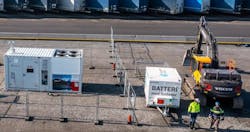Hitachi Energy Pilots H2-Fired Gen-set to Power E-Excavator Charging Station at Swedish Port Construction
Hitachi Energy worked with global construction giant Skanska Sverige AB to deploy a hydrogen-powered generator pilot project at a customer construction site in Sweden.
The two companies collaborated on efforts to decarbonize construction work at the Port of Gothenburg.
Construction contractors needing on-site electric power typically use diesel-powered generators. Hydrogen (H2) does not contain carbon in its chain so does not emit carbon dioxide (CO2) when combusted.
Hitachi Energy utilized its HyFlex hydrogen-powered generator in the pilot, its first demonstration of the technology in Sweden. The generator unit consumed green hydrogen supplied by Linde Gas to produce electricity for a charging station that supplies power to a Volvo electric excavator at the site.
“The joint project in Sweden is a testament to what is possible when like-minded companies come together with a common goal,” Marco Berardi, head of grid and power quality solutions and service at Hitachi Energy, said in a statement. “Such collaborative efforts are crucial to maturing breakthrough technologies and accelerating the industry’s journey to carbon neutrality.”
Green hydrogen is generated by electrolyzers powered by carbon-free resources such as wind, solar, battery storage, nuclear or hydropower.
Hitachi Energy estimates that using the HyFlex H2 generator can eliminate about 1,600 metric tons of diesel fuel annually, reducing 5,800 tons of CO2 emissions. A 1-megavolt diesel generator uses close to 225 kilograms (KG) of diesel and emits 720 KG of CO2 per hour, according to the project announcement.
“Fossil-free construction sites are important to the construction sector’s striving for net zero emissions,” Magnus Persson, CEO of Skanska Sverige AB, said in a statement. “To succeed in the climate transition, cooperation with other sectors is crucial. This test was made possible by the great teamwork with Hitachi Energy, Volvo and other partners.”
Among other projects, Skanska is leading work to complete a major railway link for cargo coming into and out of the Port of Gothenburg. Thirty percent of Sweden’s exported goods leave from the port, according to reports.
Hydrogen is seen as a promising tool in the decarbonization of industries such as power generation, data centers and construction. The challenge is that H2 is not mined but must be produced by one of only a few methods, such as electrolysis or steam reforming of methane gas (which contains H2 in its chain).
Hydrogen is a relatively light but energy-dense gas, making storage of it problematic. In the U.S., most natural gas pipelines are not fitted to contain hydrogen.
Global mobilization of green hydrogen infrastructure could cost $15 trillion, according to a 2021 report by the global coalition Energy Transitions Commission. Hitachi Energy is leading a massive hydrogen storage project in Utah, the Advanced Clean Energy Storage project, through a partnership with Magnum Development.
About the Author
Rod Walton, Microgrid Knowledge Head of Content
Managing Editor
For Microgrid Knowledge editorial inquiries, please contact Managing Editor Rod Walton at [email protected].
I’ve spent the last 15 years covering the energy industry as a newspaper and trade journalist. I was an energy writer and business editor at the Tulsa World before moving to business-to-business media at PennWell Publishing, which later became Clarion Events, where I covered the electric power industry. I joined Endeavor Business Media in November 2021 to help launch EnergyTech, one of the company’s newest media brands. I joined Microgrid Knowledge in July 2023.
I earned my Bachelors degree in journalism from the University of Oklahoma. My career stops include the Moore American, Bartlesville Examiner-Enterprise, Wagoner Tribune and Tulsa World, all in Oklahoma . I have been married to Laura for the past 33-plus years and we have four children and one adorable granddaughter. We want the energy transition to make their lives better in the future.
Microgrid Knowledge and EnergyTech are focused on the mission critical and large-scale energy users and their sustainability and resiliency goals. These include the commercial and industrial sectors, as well as the military, universities, data centers and microgrids. The C&I sectors together account for close to 30 percent of greenhouse gas emissions in the U.S.
Many large-scale energy users such as Fortune 500 companies, and mission-critical users such as military bases, universities, healthcare facilities, public safety and data centers, shifting their energy priorities to reach net-zero carbon goals within the coming decades. These include plans for renewable energy power purchase agreements, but also on-site resiliency projects such as microgrids, combined heat and power, rooftop solar, energy storage, digitalization and building efficiency upgrades.


